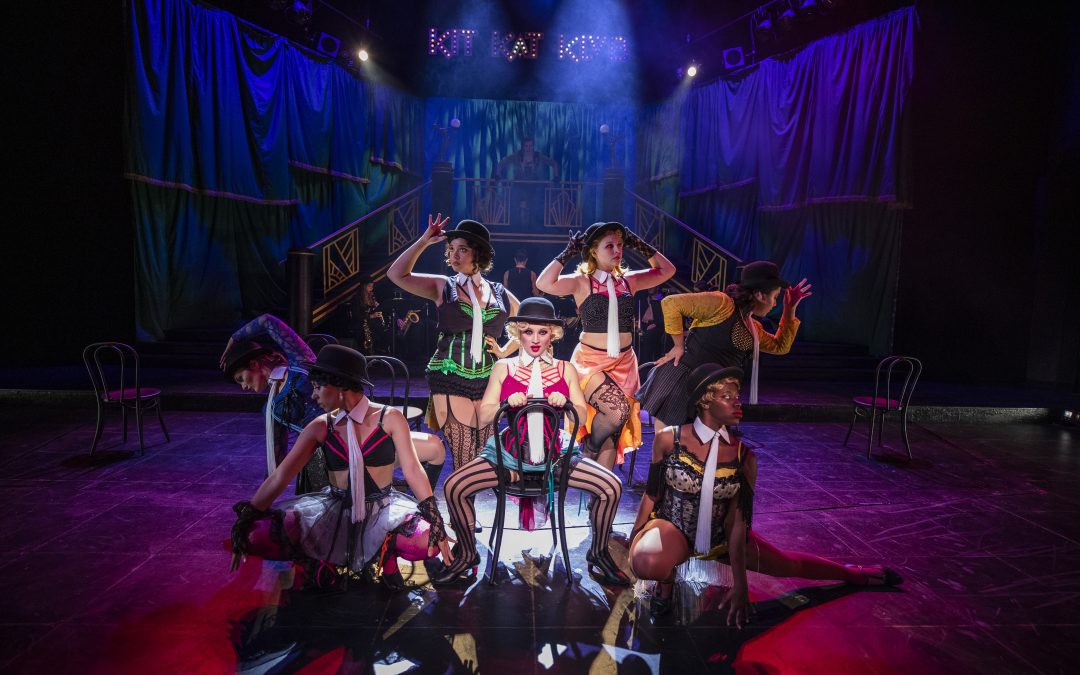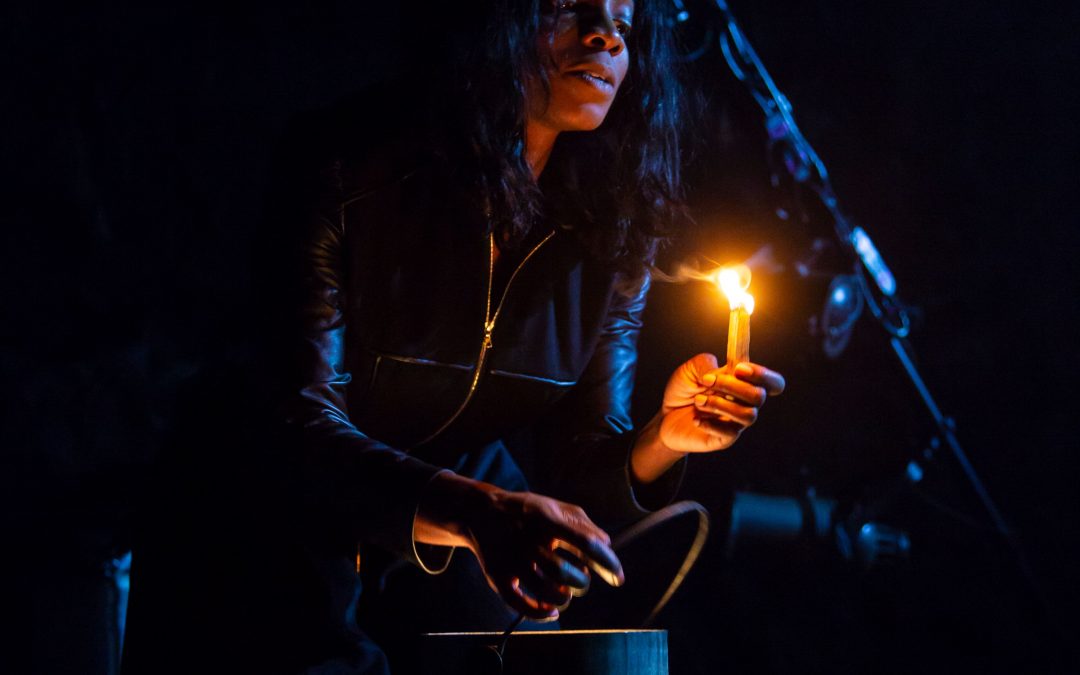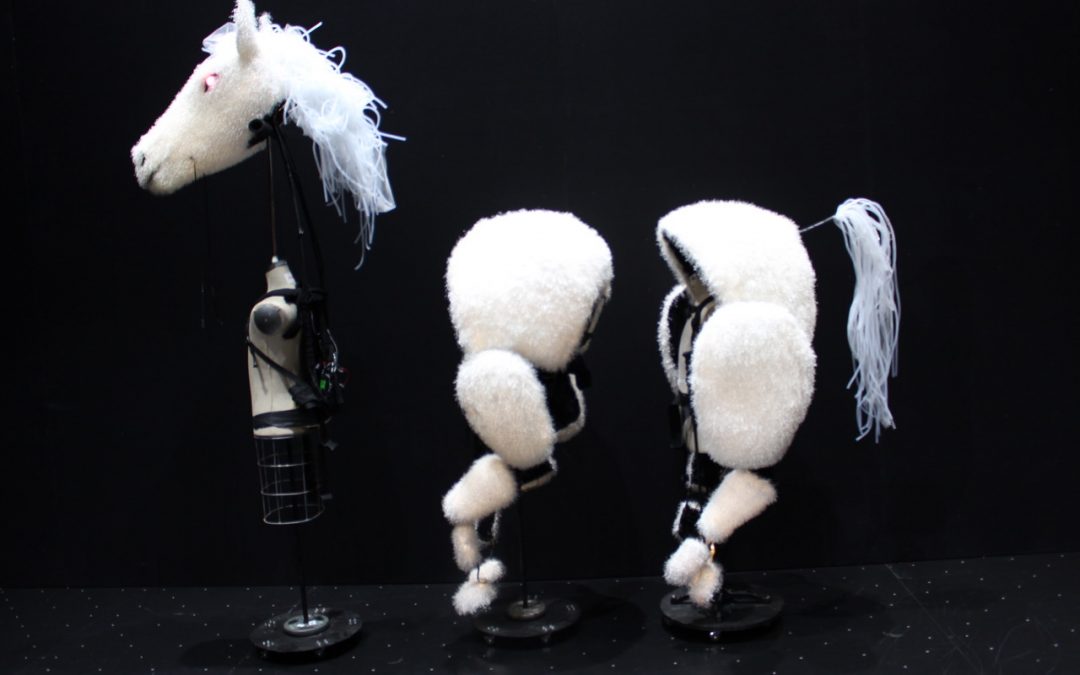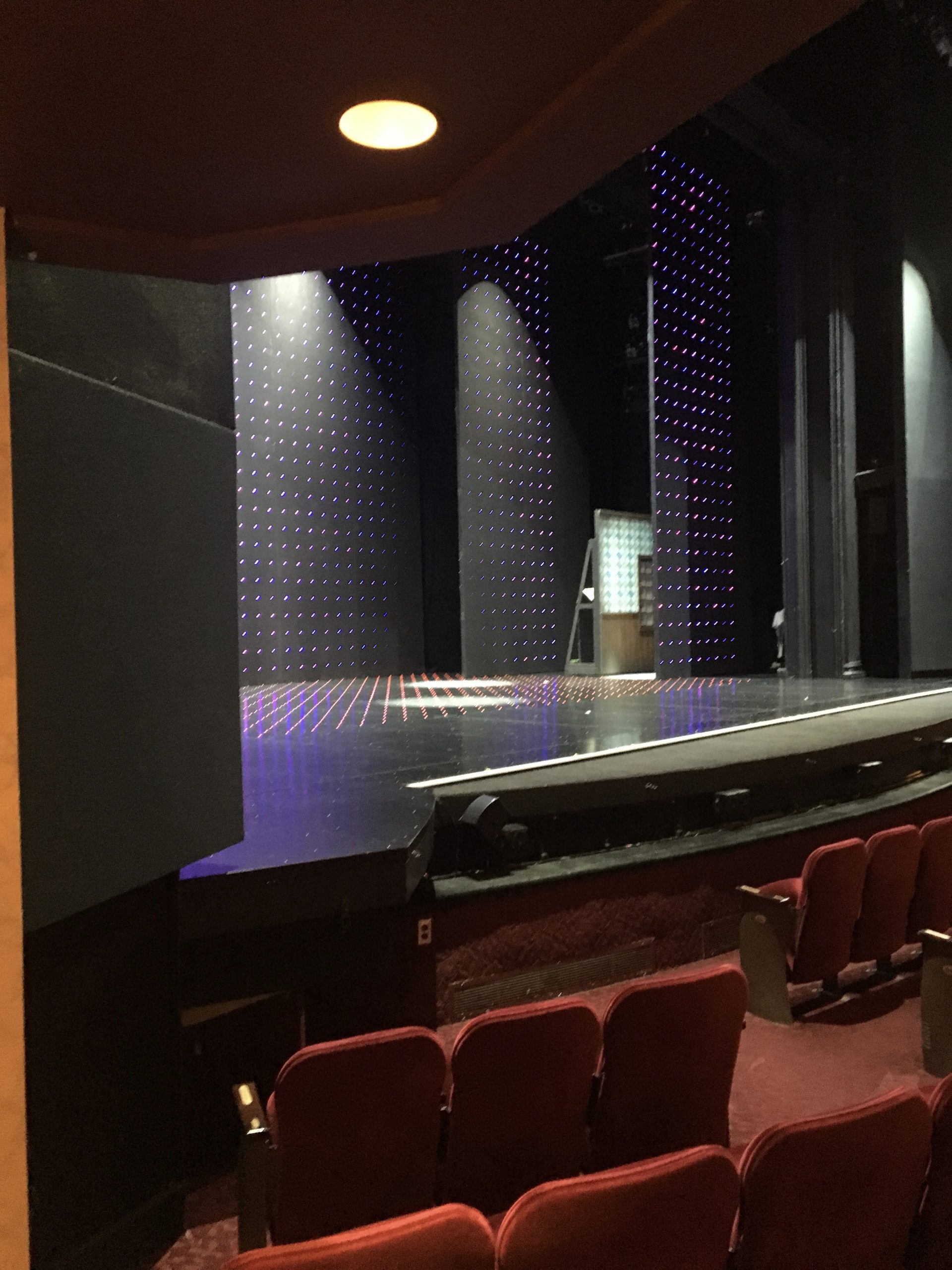
by boss | Feb 22, 2020
Cabaret has been a favorite on the stage – and on screen – since it debuted in 1966. When Theatre UNI brought Cabaret to their stage at the University of Northern Iowa, they turned to gear from RC4 Wireless to help them achieve their vision. “I had used RC4 products on a handful of shows in the last 3 years and each of those experiences had gone incredibly smoothly,” states Cabaret’s Assistant Lighting Designer, Devin Schupp.
The production required a plethora of wireless gear. Schupp continues: “We had a few different set pieces which contained a practical light fixture on them – this included two Kit Kat Klub tables each having a small table lamp in the center, a floor lamp for the interior of a boarding house, and a cue light that was part of a dressing room mirror for a Klub performer. All of these items were constructed with some variation of either 12V LED tape or individual diodes. Each of these set pieces was carried or rolled on and off the stage for particular scenes. Due to the desired fast pace of scene changes, and the huge amount of dancing in the show, it would not be very practical at all to have these as hard-wired pieces.”
The lamps and mirror lights were fairly straightforward in terms of wireless dimming and DMX. However, there were other show requirements that weren’t quite so simple. “We decided to construct three large ‘Kit Kat Klub’ signs; one for the stage, and one for each end of the building’s lobby. These signs consisted of individual LED pixels spaced out through the letters, similar to a marquee style. We wanted individual pixel control and the ability to play selected media content on the signs. Due to the layout of the facility, the two lobby signs had to receive data from the console wirelessly; there simply was no other option. Additionally, the wireless signal to the lobby would have to pass through tons of concrete and steel in order to get through the walls and to the lobby.”
For the lamps and mirror lights, the team, led by Lighting Designer Chris Wood, used RC4 Wireless 2.4GHz products, including a DMX2dim, DMX4dim, DMX4dim-500, DMX6dim with a 2.4GHz transceiver. However, for the signs located in the lobby that had to transmit through concrete and steel, the team used RC4’s 900MHz DMXio transceiver with a 900MHz DMXpix. “The 900MHz equipment made it possible to transmit through the walls and out to the lobby. Everyone on our team was thoroughly impressed with the 900MHz range of products. We were transmitting moving media content through an incredible amount of concrete and steel, and these products handled it with no lag or problems at all,” Schupp explains.
In terms of programming the furniture items, “The process was an incredibly simple ‘plug and play’ situation. The RC4 receiver was connected to the power source and the light fixture and patched into the console and written into the cues just like any other standard dimmer. No additional configuration of the receivers was required,” says the Assistant Lighting Designer.
For the Kit Kat signs, “Programming was a little more of an involved process, but very quick to pick up on. Due to a limitation of available DMX addresses, we were not able to give a unique address to every pixel in both of the lobby signs. The DMXpix has the ability to keyframe the output, which essentially repeats the address values after a certain number. For these signs, ‘pixel #1’ would be both the first pixel in the chain, as well as the next one after the midpoint. This allowed the signs to only require half the amount of DMX addresses, giving us the ability to fit both signs into the same DMX universe. The RC4 Commander software makes this process incredibly easy to figure out and fine tune to your specific needs,” Schupp explains.
The entire Cabaret team worked with the RC4 equipment on site. “Shawn Poellet [Master Electrician], Nate Brock [Asst. Master Electrician], and Alex Drelich [Asst. Master Electrician] worked together to add the lighting components to the furniture pieces, build the Klub signs, and wire all of the RC4 gear into everything,” comments Schupp.
Overall, Schupp has had positive experiences with RC4 wireless products. He explains: “Every time I have used an RC4 product, I’ve been incredibly pleased with the results; RC4 products are made for anyone. If someone simply needs a wireless dimmer — say for a handheld lantern — they just need to plug everything in, and they’re all set to go; no additional configuration is required. Opposingly, if someone needs a wireless pixel driver and has restrictions that may require advanced configuration of the receiver, those advanced capabilities are present and can be configured in a user-friendly manner.”
Schupp concludes: “RC4 products are easy to incorporate into numerous projects that can add pleasing details to any production. It is incredibly easy to get started with, and also allows for some more complex configurations for those who need it.”

by boss | Nov 7, 2019
‘The Iliad’ is an epic piece of classical poetry and has been transformed for the theater in ‘An Iliad’; earlier this year, it was presented by the Long Wharf Theatre. The Director was Whitney White, with Lighting Design by Kate McGee. “’An Iliad,’ from its conception to its present incarnation at Long Wharf, is designed to overcome every objection on which theatergoers indifferent to Homeric Greek rely when confronted with such classics. As evident in Long Wharf’s superb production, ‘An Iliad’ is as relevant and timely as the blood in your veins,” notes E. Kyle Minor of the New Haven Register.
For the production, Lighting Supervisor James Horban needed a wireless solution. He explains: “For ‘An Iliad’, we needed an effect that appeared as though a fire was lit and huddled around by the poet. From the Director’s perspective, it was a rather spiritual moment for the poet, and we went the route of lighting a Palo Santo incense stick, which then mimicked lighting a larger fire and gave off the desired smokiness. I knew that we needed a potential high-output solution due to the rock-and-roll lighting design, and I wanted to investigate a solution that gave more flexibility and options than strictly an incandescent source. A wireless solution was needed as the firepot was pulled out of a trapdoor by the poet.”
For his wireless firepot, Horban turned to RC4 Wireless, a brand he’s depended on for the past decade. “Firelight is probably some of the earliest uses of RC4, and it has changed drastically with the advent of LEDs. Our most-recent rendition mixed 3-chip RGB modules around the perimeter with some warm white tape focused in the center, driven by two RC4 DMX2dim’s. The result was the ability to program an effect with a visually red/amber edge around the firepot with a crisper tone in the center when leaned over by the actress. We used two [RC4Magic] DMX2dim units to provide 4-channels of RGBWW LED control, and recycled the sources from the infamous ‘LED scraps bin’” says Horban.
The RC4 Commander control software has also been an integral part of RC4’s usage at Long Wharf Theatre. Horban continues: “Our current show is using 8x DMX2dim RC4 units, and the show prep led me to standardize the addresses of all of our DMX devices in the department; in the past, we had one RC4 at 511, another 444, trying to use easy-to-remember ones here-and-there. It was very disorganized and dysfunctional, to say the least. So I spent the summer playing around with the RC4 Commander to standardize all of the settings across the devices and fixing one that had incorrect ID settings and wouldn’t connect. I like seeing all of the options laid out and presented in the format that RC4 Commander does.”
Like many, Horban has had to contact the RC4 support team; he chose the email route. “Customer support from RC4 was VERY quick, immediate, and solution-focused. One of our RC4 units was missing screws and bam! I had replacements with a complimentary baby screwdriver, which ALWAYS disappear. I needed our ID file for RC4 Commander and had it in my inbox in moments. In terms of customer service, I have only positive things to say!” he notes.
As for people who have not ventured into the world of RC4 Wireless, Horban concludes: “Whatever wireless solution you need, they can provide it. It can be an intimidating realm to enter into, both technologically and expense. We’ve been putting our RC4 units through hell and high water* for years, and they’re still going strong. It seems every show in our season has had some reason to need a wireless solution in some form, and I love the flexibility as one unit can drive 9v candle FX, 12v table lamp, or 24v led solution.”
* this comment is referencing metaphorical high water; although RC4 Wireless does have the best warranty in the industry, it does not cover actual high water or damage from other natural disasters like earthquakes, tsunamis or wildfires.

by boss | Sep 11, 2019
When it was time for the Geffen Playhouse in Los Angeles to mount their production of the drama ‘Mysterious Circumstances,’ which explores the death of the world’s foremost Sherlock Holmes expert — and includes Holmes himself — they turned to equipment from RC4 Wireless. “I have personally been working with RC4 products for 5 years now, but the theatre has been working with the gear much longer. We actually have an RC4 Wireless Series 2 transceiver packed away,” notes Ramine Ameli, Lighting and Projection Supervisor.
‘Mysterious Circumstances’ was chock full of action. “There ended up being a scene change every three minutes or so. So, having lots of different set pieces that could move around freely without wires really established every location,” notes Ameli.
As for the plot, “The show revolved around a box of unpublished Sherlock Holmes manuscripts, so we had three identical boxes equipped with different gags. All three boxes used an RC4 Wireless DMX2dim. The first box appeared to be floating during pre-show, and as the show began, the keyhole light-up -LED tape in a mold- and the box appeared to get sucked into the keyhole. The second version of the box had a glowing keyhole but did not open up. This was to have the audience associate this box with the one they saw in the beginning. The third version of the box had LED tape inside it to light up someone’s face as they looked into it,’ Ameli explains.
That wasn’t the only wireless used in the production. Ameli explains: “We had two tracking projections screens that were framed by brick columns that had up light scrapes and a streetlight; we also three bookshelf wagons that had additional street lights in them,” says Ameli. All were controlled via RC4 2.4GHz dimmers. “We also had a flying picture frame that had LED tape in it and a couple of furniture units that were carried on and dresses with lamps, an answering machine with a red blinking light, and a faux oil light lamp. We also had a mobile fireplace where we gutted a portable heater shaped like a log fire. It had several strips of LED tape in it – controlled via an RC4 DMX4dim – it also had a couple of birdies tucked away to send light out of the fire, and it was also equipped with a tiny fogger that received data via the 6mm DMX through the RC4 dimmer.”
For ‘Mysterious Circumstances,’ Ameli notes:” We used all of our two channel dimmers, and rented three four-channel dimmers.” Ameli has gone the rental route with RC4 before. “This is my second time renting from RC4, and every time it is a breeze. I love that you can assemble your order online and see how much it’s going to cost- which is always at a great price. I haven’t taken advantage of this yet, but the idea that you can purchase the equipment after renting, and have the price be lower is just fantastic.”
The rental department is an integral part of RC4 Wireless. “Renting is a great way for new wireless dimming and DMX users to give RC4 Wireless a try,” notes Aimee Wilson, Director of Customer Support at RC4. She adds: ”Renting is also a terrific budget-friendly option for people who already own RC4 Wireless products to expand their inventory for one particular show or project.”
In the past, she has reached out to RC4 when her team has had technical issues. “The first time I called RC4’s customer service, I was running two different shows with wireless concurrently. I was a little confused, so I gave customer support a call and they were incredibly helpful. Not only were they great to talk to, but the answers to my questions were so much simpler than I thought. The one-touch configuration is super well thought out,” she says.
As a veteran user of wireless DMX and dimming, Ameli says: “RC4 is hands down the best wireless system out there. I have a lot of people asking how we do it, and I always point them to RC4 Wireless. I have nothing but great words about RC4 products.”

by boss | Aug 30, 2019
In ‘The Neverending Story’, a young boy sneaks into a bookstore and his world gets transformed by a book that takes him on a fantastic adventure, along with Artax, his horse. As part of the stage production, Artax has to be able to transport from the stage back into the pages of the book, which isn’t an insignificant feat.
When ‘The Neverending Story’ came to the Avon Theater at the Stratford Festival, Master Electrician, Gregory Bride turned to equipment from RC4 Wireless to create his magical, pixel infused horse. “The horse was a crazy idea; we opened our big mouths and said we could do it with the RC4 DMXpix,” says Bride. The patented DMXpix is a pixel driver that can control up to 1000 pixels using a unique feature called keyframing while keeping the number of DMX channels to a manageable level. Bride continues: “I think we’re up to 8 meters of LED tape inside the horse, that is operated by three puppeteers and that’s a lot of pixels. The beauty of the DMXpix is our ability to mirror the outputs; otherwise we would be in trouble. We can arrange it so that what happens on the left side or the upstage side and the downstage side is identical.”
The technical aspects of the horse were handled by Electrician, Drew Rabbets. “I set up the horse for the show and determined the number of channels that are used. The DMXpix is great with its options in RC4 Commander configuration software. It was really easy to determine the type of product that is used and the number of channels as well as the starting address,” he explains. This is Rabbets’ first time with RC4 gear and the patented DMXpix pixel driver. “The RC4 DMXpix makes controlling a large number of pixels very easy with the double outputs, I was able to clone each output which cut the number of addresses in half, as well as the option of the keyframe makes it much easier on the console,” Rabbets adds.
The horse alone uses one universe of DMX. In ‘The Neverending Story’, we have four universes; the fourth universe being our test universe,” says Bride. There are another two universes in the Studio Theatre, which shares a wall with the Avon Theatre. That could mean wireless issues; that’s not the case, because the Avon Theater is using RC4 Wireless equipment. “One of the important things about RC4 for us is that we can do Private IDs,” Bride explains. Private IDentities are RC4’s trademarked way of keeping each and every RC4 wireless system safe from other systems. “All pro-grade wireless DMX technology provides some form of security, but none provide the flexibility of RC4 Private IDentities. Every customer and project is assigned a set of unique codes that belong only to them — your IDs can never interfere with anyone else’s. And the biggest benefit: when a forklift truck runs over your DMXio transmitter during load-in, you can grab another one, and not have to re-link all the receivers and dimmers in the show. There’s nothing else that is both secure and super serviceable, which is why Disney, Cirque du Soleil, Blue Man Group, and many others depend on RC4. RC4 can deliver up to 12 wireless universes in the 2.4GHz band, and 8 in the 900MHz band, all with superior range compared to other systems. With recent talk from others about multiple universes and more economical use of bandwidth, I have to point out that RC4 has been doing all of this for a decade already; as the designer, I’ve known for all that time that channel count, security, and bandwidth economy are paramount to our users,” notes RC4 Wireless CEO and Product Developer, James D. Smith. As for ‘The Neverending Story’, Bride notes, “We’re using three separate IDs at the same time, and we haven’t had any issues at all.”
The eyes of Artax the horse also play a critical role in the production. “The blue eyes on the horse are very important because the eye flies in the show. When the story is told in print, that eye disappears on the horse and it flies on the back screen, over to the storyteller and it goes into his book. So we had to be able to match the color on the horse on the back screen so it looked like that same color was flying on the back screen,” explains Bride.
The back screen is comprised of approximately 3000 pixels, and is hard wired. However, RC4 played a part in its creation. Bride explains: “We used RC4 gear to test the back screen; we used it to do all the testing and the proof of concept. Specifically, we used the DMXpix driver to prove the concept to the designers. We also had to be able to construct the screen very quickly in the design phase, which is why we used RC4 Wireless equipment.”
This is Bride’s first time with the DMXpix. Bride says, “I saw them in trade magazines, and as soon as I could, I ordered one. I knew that we would use it somehow.” His current inventory of RC4 Wireless 2.4GHz equipment is approximately 70 units. “You name it, we’ve got it in 2.4GHz; they work very well. We’re using approximately 40 of the packs for ‘The Neverending Story’; we even have one of the micro dimmers — the DMX2micro — in place in a headdress.” Rabbets adds: “I have been very impressed with the entire line of products; we are using a combination of the packs over 3 different transmitters and we have not had any issues.”
For those that are wireless curious, Bride has some advice: “Know what you’re trying to do first and then ask your questions. That’s the advice I give my techs. We’ll work something up and then solve our own problem. It’s usually not an RC4 problem.” Rabbet adds: “Anyone starting out with RC4 Wireless needs to take the time to really get to know the ins and out of the product and how you intend to use it. The RC4 Wireless system is not difficult but you really do need to understand how it works so when you get into a jam you can deal with it. The biggest thing is to have good decimation on a larger setup of RC4 units; with the DMXpix I took screenshots of RC4 Commander to ensure that the settings can be tracked.”
If, for some reason, there is an issue with the equipment, Bride – and all RC4 users – have the confidence of the RC4Magic Lifetime Warranty. Bride says: “That’s the great thing about the confidence that comes with the warranty. If we’re negligent with the product, we pay to have it fixed. We had a problem a while back, and when I called customer service, they immediately took care of it. A new unit was overnighted to us, so we had a spare.”
In terms of RC4’s customer service, Rabbets says, “I have had to call customer service several times as well as using the online service portal via email and my questions were very quickly answered, as we all know during production setup time is at a premium so a quick response is greatly appreciated.”
For Bride the best part of ‘The Neverending Story’ is the melding of technology and a story. “The technology is there to tell the story. The directors and designers had a clear vision, but the technology is there to tell the story. I love doing all these things, but when they support the story, it’s marvelous to work on technology when it is on a show where they are thoughtful. They came to us and said how do we do this and we said we’ll find a way to make it work.
And we did,” he concludes. 

by boss | Jul 17, 2019
In Europe, Robbie Williams is a legend; he regularly fills stadiums and his productions are some of the most anticipated on the continent. One of his dreams was to do a Vegas show, and to make every detail of Williams’ show perfect, Production and Lighting Designer Sean Burke, principal at Holes in the Dark, needed reliable wireless DMX technology. “When the wireless stuff came up, I did a bit of research on it, looked around, and saw that Baz [Halpin, of Silent House Productions] used RC4 Wireless products on the last Katy Perry tour. I know the crew chief, and he said they didn’t have any problems with it,” confides Burke. That was enough for him to entrust RC4 Wireless with the job for Williams’ “Live in Las Vegas” show. Matt Bakken, the Master Electrician on the show, adds: “When a lot of people in the touring industry use wireless, they use equipment from RC4; to me, if your wireless is working in a stadium with 25,000 plus people with cell phones, that’s good enough for me.”
For the Williams’ production, the team built their system around an RC4Magic Series 3 DMXio-HG Transceiver with External Antenna; working along with the DMXio are six RC4Magic Series 3 DMX4dim 4-Channel Wireless Dimmers. “Addressing was easy and very straight forward; pairing the receivers with the transceivers was simple as well. The system was exactly what I wanted and it just worked,” reports Bakken.
There are several props using the RC4 Wireless DMX4dims; specifically, two giant Martini glasses and four stylized box frames, called Gogo frames. “The GoGo frames are open aluminum frames that the dancers push around and dance inside. The Gogo frames and the Martini glasses have wireless receivers on board and battery packs, so they are completely wireless,” explains Burke. In terms of batteries, Bakken adds, “The batteries are lasting pretty much forever on them, and sometimes they forget to plug them in to charge them.” Both the Gogo frames and the Martini glasses were manufactured by ShowFX, who also handled the Katy Perry props.
“After working in the professional theatre world for a few years, I founded RC4 in 1991,” says James David Smith, also the Chief Product Developer. “Our DMX4dim wireless dimmers are the pinnacle of design, and can control LEDs, halogen lamps, position servo motors, ring telephones, and more. The RC4 ColorMatch feature lets you color-correct LEDs from different manufacturers to deliver the same color palette across all props and scenery.”
It’s no secret that Las Vegas is a busy wireless environment. “We have several wireless systems running concurrently; at no point did I see any signal degradation or interference,” says Bakken. Placement of the transceiver is also important. “I try to mitigate any potential issues by putting the transceiver right down by the proscenium on the stage, so there would be no problems. And there weren’t,” Bakken adds.
The ability to punch through crowded wireless areas is a fundamental part of all RC4 Wireless products. “The entire RC4Magic Series 3 system, starting with the DMXio-HG transceiver, uses proprietary wireless technology unlike any other,” explains Smith. “It consumes just 1/15th of the 2.4GHz radio band and punches through the noise like nothing else.”
There are many in the industry that are cautious of wireless dimming and DMX. “I know a lot of people who are incredibly wary of wireless because they have been burned in the past. When you’re using it, your wireless must work,” states Bakken. The RC4 products on Williams’ show proved their worth night after night. Bakken says: “RC4 gear works well and that’s all I can ask for. If you haven’t used it, you should give it a shot.”
Robbie Williams concluded his stint in Vegas on July 6th; however, the U.K. press reports that he’s close to inking a six figure residency deal there.





